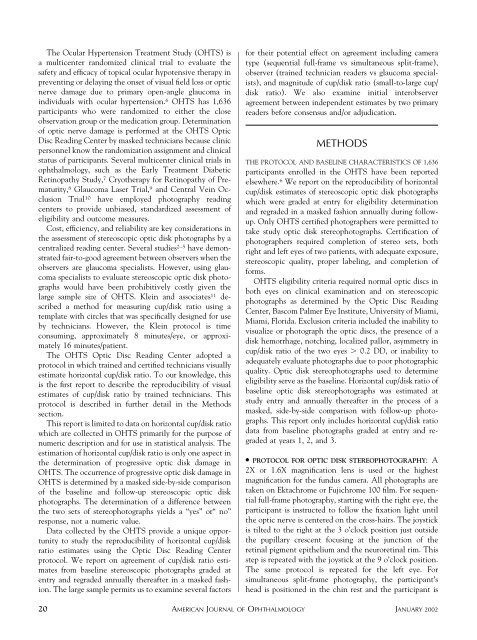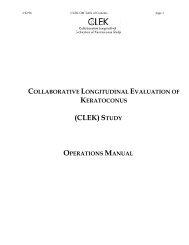The Ocular Hypertension Treatment Study - Vision Research ...
The Ocular Hypertension Treatment Study - Vision Research ...
The Ocular Hypertension Treatment Study - Vision Research ...
You also want an ePaper? Increase the reach of your titles
YUMPU automatically turns print PDFs into web optimized ePapers that Google loves.
<strong>The</strong> <strong>Ocular</strong> <strong>Hypertension</strong> <strong>Treatment</strong> <strong>Study</strong> (OHTS) isa multicenter randomized clinical trial to evaluate thesafety and efficacy of topical ocular hypotensive therapy inpreventing or delaying the onset of visual field loss or opticnerve damage due to primary open-angle glaucoma inindividuals with ocular hypertension. 6 OHTS has 1,636participants who were randomized to either the closeobservation group or the medication group. Determinationof optic nerve damage is performed at the OHTS OpticDisc Reading Center by masked technicians because clinicpersonnel know the randomization assignment and clinicalstatus of participants. Several multicenter clinical trials inophthalmology, such as the Early <strong>Treatment</strong> DiabeticRetinopathy <strong>Study</strong>, 7 Cryotherapy for Retinopathy of Prematurity,8 Glaucoma Laser Trial, 9 and Central Vein OcclusionTrial 10 have employed photography readingcenters to provide unbiased, standardized assessment ofeligibility and outcome measures.Cost, efficiency, and reliability are key considerations inthe assessment of stereoscopic optic disk photographs by acentralized reading center. Several studies 2–5 have demonstratedfair-to-good agreement between observers when theobservers are glaucoma specialists. However, using glaucomaspecialists to evaluate stereoscopic optic disk photographswould have been prohibitively costly given thelarge sample size of OHTS. Klein and associates 11 describeda method for measuring cup/disk ratio using atemplate with circles that was specifically designed for useby technicians. However, the Klein protocol is timeconsuming, approximately 8 minutes/eye, or approximately16 minutes/patient.<strong>The</strong> OHTS Optic Disc Reading Center adopted aprotocol in which trained and certified technicians visuallyestimate horizontal cup/disk ratio. To our knowledge, thisis the first report to describe the reproducibility of visualestimates of cup/disk ratio by trained technicians. Thisprotocol is described in further detail in the Methodssection.This report is limited to data on horizontal cup/disk ratiowhich are collected in OHTS primarily for the purpose ofnumeric description and for use in statistical analysis. <strong>The</strong>estimation of horizontal cup/disk ratio is only one aspect inthe determination of progressive optic disk damage inOHTS. <strong>The</strong> occurrence of progressive optic disk damage inOHTS is determined by a masked side-by-side comparisonof the baseline and follow-up stereoscopic optic diskphotographs. <strong>The</strong> determination of a difference betweenthe two sets of stereophotographs yields a “yes” or“ no”response, not a numeric value.Data collected by the OHTS provide a unique opportunityto study the reproducibility of horizontal cup/diskratio estimates using the Optic Disc Reading Centerprotocol. We report on agreement of cup/disk ratio estimatesfrom baseline stereoscopic photographs graded atentry and regraded annually thereafter in a masked fashion.<strong>The</strong> large sample permits us to examine several factorsfor their potential effect on agreement including cameratype (sequential full-frame vs simultaneous split-frame),observer (trained technician readers vs glaucoma specialists),and magnitude of cup/disk ratio (small-to-large cup/disk ratio). We also examine initial interobserveragreement between independent estimates by two primaryreaders before consensus and/or adjudication.METHODSTHE PROTOCOL AND BASELINE CHARACTERISTICS OF 1,636participants enrolled in the OHTS have been reportedelsewhere. 6 We report on the reproducibility of horizontalcup/disk estimates of stereoscopic optic disk photographswhich were graded at entry for eligibility determinationand regraded in a masked fashion annually during followup.Only OHTS certified photographers were permitted totake study optic disk stereophotographs. Certification ofphotographers required completion of stereo sets, bothright and left eyes of two patients, with adequate exposure,stereoscopic quality, proper labeling, and completion offorms.OHTS eligibility criteria required normal optic discs inboth eyes on clinical examination and on stereoscopicphotographs as determined by the Optic Disc ReadingCenter, Bascom Palmer Eye Institute, University of Miami,Miami, Florida. Exclusion criteria included the inability tovisualize or photograph the optic discs, the presence of adisk hemorrhage, notching, localized pallor, asymmetry incup/disk ratio of the two eyes 0.2 DD, or inability toadequately evaluate photographs due to poor photographicquality. Optic disk stereophotographs used to determineeligibility serve as the baseline. Horizontal cup/disk ratio ofbaseline optic disk stereophotographs was estimated atstudy entry and annually thereafter in the process of amasked, side-by-side comparison with follow-up photographs.This report only includes horizontal cup/disk ratiodata from baseline photographs graded at entry and regradedat years 1, 2, and 3.● PROTOCOL FOR OPTIC DISK STEREOPHOTOGRAPHY: A2X or 1.6X magnification lens is used or the highestmagnification for the fundus camera. All photographs aretaken on Ektachrome or Fujichrome 100 film. For sequentialfull-frame photography, starting with the right eye, theparticipant is instructed to follow the fixation light untilthe optic nerve is centered on the cross-hairs. <strong>The</strong> joystickis tilted to the right at the 3 o’clock position just outsidethe pupillary crescent focusing at the junction of theretinal pigment epithelium and the neuroretinal rim. Thisstep is repeated with the joystick at the 9 o’clock position.<strong>The</strong> same protocol is repeated for the left eye. Forsimultaneous split-frame photography, the participant’shead is positioned in the chin rest and the participant is20 AMERICAN JOURNAL OF OPHTHALMOLOGYJANUARY 2002
















